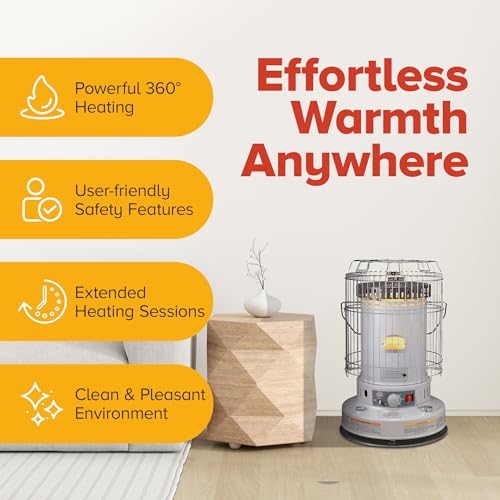Description
Product Description
Kero World is the brand trusted by millions since 1982. Quality materials and construction, along with a 2-year warranty, makes this heater brand a standout. The KW-24G convection style heater is a popular choice. It projects 23,800 BTU’s of heat in a 360 degree radius to heat a large area. Also great for winter power outages and emergency situations as it provides both heat and light.
Amazon.com
The Kero World portable indoor kerosene heater is great for heating small to medium indoor spaces (up to 900 square feet). Matchless ignition makes this a convenient source of instant heat–without having to plug it in, either. The built-in 1.9-gallon tank gives you up to 12 hours of heat. The manufacturer recommends using only clean kerosene. Two-year warranty.–Josh Dettweiler
What’s in the Box
Heater, C batteries (2)
Five Tips for Buying a Heater
Choosing a space heater is a matter of sifting through a bewildering array of types, power ratings, and fuel sources. Let’s break it down a little to make the process easier.
What are the different types of space heaters?
- Radiant heaters emit infrared radiation that directly warms the objects in front of the heaters (rather than the surrounding air). If you only need heat by a desk or in a small section of a room, a radiant heater is quiet and will use very little power.
- Forced-air heaters use a fan to blow air that has been warmed by metal or ceramic heating elements. A forced-air heater is appropriate for quickly heating up a small- to medium-sized room, but can be noisy.
- Convection heaters draw cold air from the floor; the air is warmed by heating coils and emitted from the top of the heater. A convection heater is appropriate for quickly heating up a small- to medium-sized room, but also can be noisy.
- Radiators work by heating oil enclosed in a reservoir, gradually heating the surrounding air. If heating speed isn’t an issue, you might want to opt for a radiator. These are extremely quiet and effective–perfect for bedrooms.
Should I buy an electric or a combustion model?
If you want a heater that will be available in emergencies, or that can heat areas larger than a single room, choose a “combustion” model–one that is powered by a gas or fuel like propane, kerosene, natural gas, or diesel. Which fuel type you choose depends largely on convenience and local availability. For example, diesel would be appropriate for a heater you take with you on long car trips.
How powerful a heater do I need?
Heaters are rated by BTU, which stands for British Thermal Unit (the amount of heat needed to heat one pound of water by 1 degree F). To find out how many BTU you need:
- Calculate the volume of the space to be heated by multiplying square footage by height.
- Multiply that number by 4 if your insulation is poor, 3 if it’s average, or 2 if it’s good.
The resulting number is a ballpark figure for how many BTU you’ll need.
Do space heaters cost a lot to operate?
As a general rule, electric space heaters are more expensive to use than combustion models. To ensure energy efficiency, a thermostat is a must-have feature for any heater. For radiant heaters, models with a 360 degree heating surface can heat larger spaces. If you need a forced-air heater, models with ceramic elements tend to be more efficient.
Are space heaters a fire hazard?
Space heaters are implicated in about 25,000 residential fires every year. To ensure proper safety, always follow the manufacturer’s usage instructions and fill out the warranty card to receive informational updates from the manufacturer. Also, look for extra safety features such as an automatic shutoff switch that can shut down the unit if, for example, it gets upended. In addition, choose a model where the heating element is adequately enclosed within the unit.
360 degree heating radius
Push to start ignition
Accidental tip-over shut-off
Operates 8-12 hours on one tank of fuel
2-Year warranty
Additional information
| Brand | |
|---|---|
| Color | |
| Manufacturer |






















